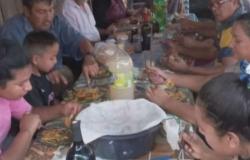After 12 years of absence, due to the Second World War, London hosted the return of the Olympic Games. However, the fourteenth edition was marked by that conflagration, so much so that the battered post-war economy led to it being dubbed the Austerity Games.
The British capital was going through a reconstruction process to heal the impact of the German bombings, which cost the lives of more than 30,000 Londoners. The population lacked basic goods, so many of its inhabitants rejected the celebration.
No new Olympic facilities were built, existing ones were used. Wembley Stadium, the same one that hosted the Champions League final this month, full of technical advances, was adapted to be the Olympic venue, with a cinder track for athletics.
More than ten years without Games meant that many athletes left behind their best years of performance, and others died during the war. That was a high cost for London-1948 in the sporting order, since the number of brands was very low in relation to other events.
Even so, the Dutch Fanny Blankers-Koen, known as the Dutch lightning bolt, won four titles in athletics; Alice Coachman was the first African-American woman to win a gold medal, and the top medalist was the Finnish gymnast Veikko Huhtanen, with five medals, three of them gold.
Volunteer workers also had their first times, a tradition that has continued to this day; Nor had swimming competitions been held in indoor pools before, as in London, at the Empire Pool, now Wembley Arena.
But they had one last time. There ended the artistic competitions, rewarded with medals, introduced in Stockholm-1912, in sculpture, painting, music, literature and architecture. The International Olympic Committee (IOC) questioned its permanence because the number of participants had already decreased in Berlin-1936.
The 1952 Games were very different. The 15th edition, in Helsinki, found a Finland that did have, unlike other nations affected by the war, a good economic situation. Four more years gave the athletes the opportunity to have better preparation, and that resulted in this call going down in history as the one with the most Olympic and world records. In athletics alone, 20 records were surpassed under the five rings, and six in the world. Such records were not surpassed until Beijing 2008.
Czech Emil Zátopek was the author of three of these records, winning a triplet, still unpublished, in 5,000 and 10,000 meters, and in the marathon. His feat earned him the nickname the Human Engine, and his happiness in the Finnish capital was crowned with the golden prize of his wife, Dana Zátopková, in the javelin throw.
Zátopek was one of the first technicians from the socialist camp who helped the development of Cuban athletics, and to him, accompanied by two wise men, Enrique Figuerola and Lázaro Betancourt, we owe the discovery of the eastern gazelle, Miguelina Cobián. The woman from Santiago was a silver medalist in Mexico-1968, in the 4×100 relay.
The lighting of the cauldron by Paavo Nurmi, winner of 12 Olympic medals (9 gold), between 1920 and 1928, was very emotional. His arrival surprised Sigfrid Edström, president of the IOC. In 1932, the International Athletics Association, then chaired by Edström, prevented Nurmi from competing in the Los Angeles Olympic Games, claiming that he was a professional athlete for accepting money to travel to that city. Twenty years later, Finnish president Urho Kekkonen convinced Nurmi to participate in the event.
Yes, there were news. For the first time, the riding trials allowed riders who were not military officers, including women; and for the first and only time, Luxembourg appeared at the top of the podium, with Josy Barthel, winner of the 1,500 meters.






